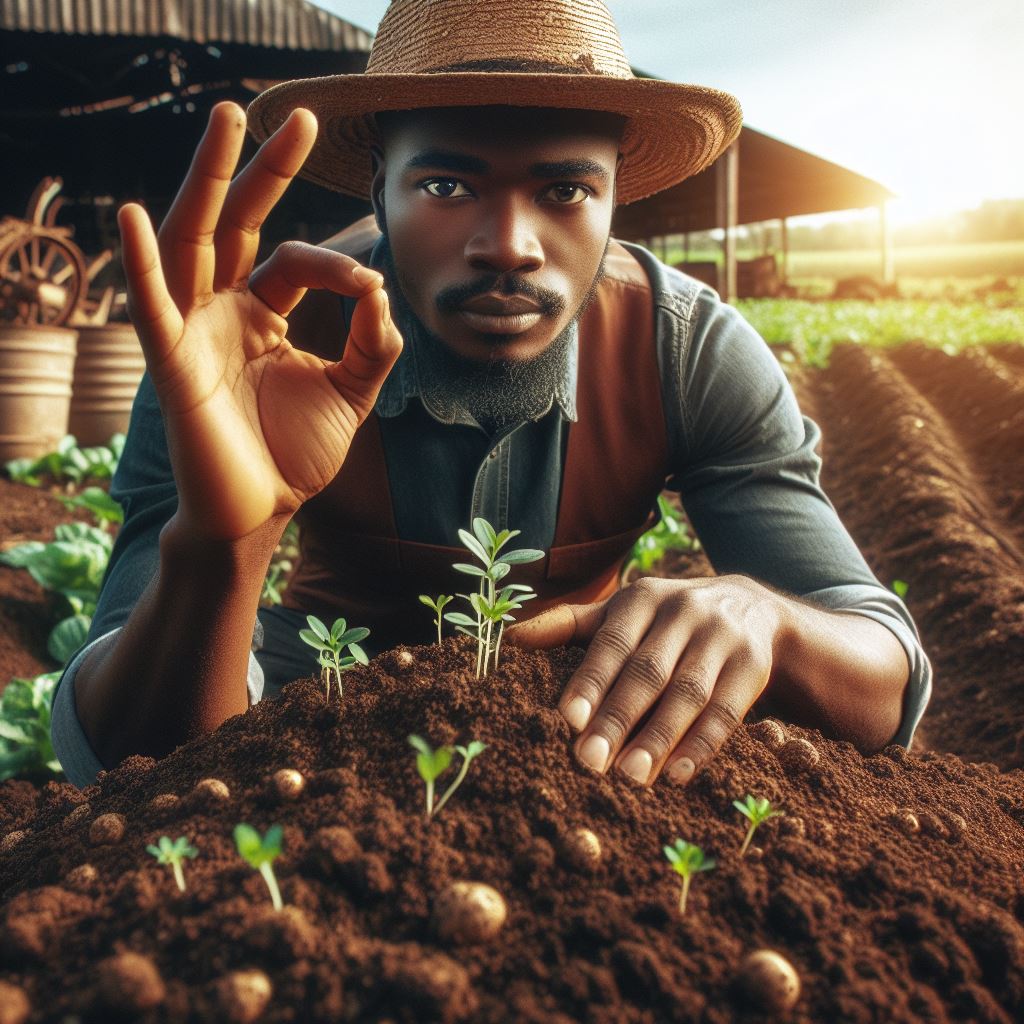Introduction
Understanding soil texture is crucial for farmers and agriculturalists as it directly affects crop growth and yield.
Soil texture refers to the composition of soil particles, including sand, silt, and clay.
These particles determine the soil’s ability to hold water, nutrients, and support plant roots.
The importance of understanding soil texture lies in its impact on various aspects of crop development.
For instance, sandy soils, which have larger particles, drain water quickly, making them drought-prone.
On the other hand, clay soils, with smaller particles, have a higher water-holding capacity but can become waterlogged, affecting root growth.
Soil texture also affects nutrient availability for crops. Sandy soils have low nutrient-retaining capacity, making them less fertile.
In contrast, clay soils have a higher nutrient-holding capacity but may require better management to prevent nutrient leaching.
Understanding soil texture helps farmers optimize nutrient application to support crop growth and avoid wastage.
Additionally, soil texture influences the soil structure, which affects root penetration and development.
Sandy soils have loose structures, allowing roots to penetrate easily, but they can lack stability and retention of water and nutrients.
Clay soils have dense structures, making it difficult for roots to penetrate.
The ideal soil texture is loam, a balanced mixture of sand, silt, and clay particles, which offers good drainage, nutrient retention, and root penetration.
In essence, comprehending soil texture is essential for successful agriculture.
Understanding how different soil textures impact crop growth and yield allows farmers to make informed decisions about irrigation, fertilization, and plant selection.
Transform Your Agribusiness
Unlock your farm's potential with expert advice tailored to your needs. Get actionable steps that drive real results.
Get StartedBy optimizing soil texture, farmers can maximize crop productivity and minimize resource waste, contributing to sustainable and efficient agricultural practices.
What is Soil Texture?
Soil texture refers to the composition of soil based on the proportion of sand, silt, and clay particles.
Components of soil texture
- Sand: It is the largest soil particle and can be identified by its gritty texture.
- Silt: It is smaller than sand particles but larger than clay particles. Silt feels smooth and powdery.
- Clay: It is the smallest soil particle and has a sticky texture when wet.
Importance of soil texture for plant growth
- Water retention: Soil texture affects the ability of soil to retain water. Sandy soils drain quickly, while clay soils retain more water.
- Aeration: Soil texture affects the porosity of soil, which determines the air spaces available for roots to breathe. Sandy soils have better aeration.
- Nutrient availability: Soil texture influences nutrient availability to plants. Clay soils can retain more nutrients than sandy soils.
- Root development: Soil texture affects root penetration and development. Sandy soils allow easier root growth, while clay soils can hinder it.
- Soil structure: Soil texture influences soil structure, which affects soil fertility and water movement. Balanced texture promotes healthy soil.
- Crop suitability: Different crops have varying soil texture preferences. Understanding soil texture helps in choosing suitable crops for specific soils.
- Soil management: Knowing soil texture is essential for proper soil management practices like irrigation, fertilization, and soil amendments.
Understanding soil texture is crucial for farmers and gardeners for optimal crop production
- Soil testing: Soil texture analysis can be done through laboratory tests to determine the percentage of sand, silt, and clay in a soil sample.
- Texture classification: Soil texture classification based on the percentage of sand, silt, and clay helps in characterizing soil for agricultural purposes.
- Soil improvement: Knowing the soil texture helps in determining the need for soil amendments to improve soil drainage or water-holding capacity.
- Irrigation scheduling: Soil texture affects irrigation needs. Sandy soils require more frequent watering, while clay soils can hold moisture longer.
- Nutrient management: Soil texture determines nutrient requirements. Sandy soils may need more frequent fertilization, while clay soils need proper nutrient balance.
- Crop selection: Being aware of soil texture can guide farmers in selecting crops that thrive in specific soil types, maximizing yield and quality.
- Conservation practices: Understanding soil texture aids in implementing conservation practices like contour plowing or terracing to prevent soil erosion.
In fact, soil texture plays a vital role in plant growth and crop production. Understanding the composition of soil and its texture helps farmers and gardeners make informed decisions regarding soil management, irrigation, nutrient application, and crop selection.
By recognizing the importance of soil texture, we can optimize agricultural practices and promote sustainable farming.
Determining Soil Texture
There are several methods available for determining soil texture, including the feel method, ribbon test, and sedimentation method.
Accurate identification of soil texture is crucial for understanding its characteristics and managing crops effectively.
Soil texture has a significant impact on moisture retention and drainage within the soil profile.
Methods for Determining Soil Texture
- Feel method: This method involves rubbing moist soil between fingers to determine its texture based on sensations.
- Ribbon test: By making soil into a ribbon, one can assess its texture and how well it holds together.
- Sedimentation method: This method involves measuring the settling rates of soil particles in water to determine texture.
Importance of Accurate Soil Texture Identification
Accurately identifying soil texture is essential for various reasons:
- Soil texture affects water infiltration and drainage, which impact the plant’s root development and health.
- It determines the soil’s potential for erosion and runoff, which can lead to environmental issues.
- Soil texture affects the availability of nutrients to plants, influencing their growth and yield.
- Understanding soil texture helps in selecting appropriate management practices and soil amendments.
How Soil Texture Affects Moisture Retention and Drainage
Soil texture plays a crucial role in moisture retention and drainage ability:
- Sandy soils: Sandy soils have larger particles, allowing water to pass through quickly. They tend to have low moisture retention.
- Clay soils: Clay soils have fine particles, which tightly pack together, resulting in poor water drainage. They have high moisture retention.
- Silt soils: Silt soils have moderate-sized particles and offer a balance between moisture retention and drainage.
- Loam soils: Loam soils, a mixture of sand, silt, and clay, have good moisture retention and drainage characteristics, making them ideal for crop growth.
The moisture retention and drainage capacity of a soil directly influence plant water availability and root health.
In general, accurate identification of soil texture is vital for successful crop management. Various methods, such as the feel method, ribbon test, and sedimentation method, can be used to determine soil texture.
Understanding the soil texture allows farmers to make informed decisions regarding irrigation, drainage, and nutrient management. Sandy, clay, silt, and loam soils each have distinct moisture retention and drainage characteristics that impact plant growth.
To optimize crop production, it is crucial to tailor management practices according to the specific soil texture present in the field.
Read: Drip Irrigation: Saving Water in Crop Fields
Soil Textures and Crop Suitability
Sandy Soils
- Characteristics and properties: Sandy soils have large particles and low water-holding capacity, which leads to fast drainage and poor nutrient retention.
- Crops suitable for sandy soil conditions: Crops like carrots, lettuce, and radishes thrive in sandy soils due to their preference for well-drained conditions.
- Challenges and management practices for sandy soils: Challenges include nutrient leaching, irrigation requirements, and low fertility. Adding organic matter can improve the soil’s nutrient-holding capacity.
Silt Soils
- Characteristics and properties: Silt soils have medium-sized particles, providing a balance between sand and clay. They have good water-holding capacity.
- Crops suitable for silt soil conditions: Crops such as corn, soybeans, and spinach can excel in silt soils due to their ability to retain moisture.
- Challenges and management practices for silt soils: Silt soils are prone to compaction and can become waterlogged. Proper drainage systems and crop rotation help mitigate these issues.
Clay Soils
- Characteristics and properties: Clay soils have fine particles, resulting in high water retention and slow drainage. They are known for their ability to hold nutrients.
- Crops suitable for clay soil conditions: Crops like wheat, barley, and beans are well-suited to clay soils due to their capacity to extract nutrients from the soil.
- Challenges and management practices for clay soils: Clay soils are prone to compaction, poor drainage, and difficulty in root penetration. Adding organic matter, tilling, and proper irrigation management can help improve clay soils.
Understanding the soil texture is crucial for determining the suitability of crops. Sandy soils, characterized by their large particles and low water-holding capacity, require proper management practices to overcome their challenges.
Crops that can thrive in sandy soils include carrots, lettuce, and radishes.
On the other hand, silt soils provide a balance between sand and clay, allowing for adequate water retention. Crops such as corn, soybeans, and spinach can flourish in silt soils due to their ability to retain moisture.
However, silt soils are prone to compaction and waterlogging, necessitating drainage systems and crop rotation.
Clay soils, with their fine particles and high water retention capacity, possess rich nutrient content. Wheat, barley, and beans are suitable crops for clay soils as they can efficiently extract nutrients from the soil.
The challenges faced when dealing with clay soils include compaction, poor drainage, and limited root penetration.
To improve clay soils, incorporating organic matter, implementing tilling techniques, and managing irrigation properly can be beneficial. These practices enhance soil structure, drainage, and overall fertility.
In short, different soil textures have specific characteristics, crop suitability, and management practices.
Understanding these aspects is vital for successful crop production. By addressing the challenges associated with each soil texture, farmers can optimize their farming practices and yield better results.
Read: Innovative Farming in Changing Climates
Showcase Your Farming Business
Publish your professional farming services profile on our blog for a one-time fee of $200 and reach a dedicated audience of farmers and agribusiness owners.
Publish Your Profile
Find Out More: Organic Methods for Disease Control
Soil Texture and Nutrient Availability
- Soil texture plays a significant role in the retention and availability of nutrients.
- Different soil textures have varying nutrient requirements for optimal crop growth.
- Fertilizer application recommendations should be based on the specific soil texture of the area.
Influence of Soil Texture on Nutrient Retention and Availability
Soil texture, which refers to the relative proportions of sand, silt, and clay particles, can greatly affect nutrient retention and availability.
For example, sandy soils have larger pore spaces and lower cation exchange capacity (CEC), making them prone to nutrient leaching and less capable of retaining and supplying nutrients to plants.
In contrast, clay soils have smaller pore spaces and higher CEC, leading to better retention and availability of nutrients.
Silt soils fall in between sandy and clay soils, with moderate nutrient retention capabilities.
Nutrient Requirements of Different Soil Textures
Different soil textures have specific nutrient requirements for optimal crop growth.
Sandy soils, being more prone to nutrient leaching, generally require more frequent fertilization to compensate for nutrient losses. They often also need higher amounts of micronutrients.
Clay soils, on the other hand, have higher nutrient retention capacities and may require less frequent fertilization. However, they may also have a lower availability of certain nutrients due to their higher CEC.
Silt soils have nutrient requirements that lie between sandy and clay soils, usually needing moderate fertilization practices.
Fertilizer Application Recommendations Based on Soil Texture
Appropriate fertilizer application recommendations should be tailored to the specific soil texture of the area.
For sandy soils, it is essential to choose fertilizers with slow-release formulations to prevent nutrient leaching. Split applications throughout the growing season are also beneficial to ensure a continuous nutrient supply.
Clay soils may benefit from fertilizers with higher ammonium content, as ammonium ions are less prone to leaching compared to nitrate ions. Applying fertilizers before planting or during soil preparation can also allow better nutrient incorporation.
Silt soils typically respond well to balanced fertilizers that meet both macronutrient and micronutrient requirements.
Split applications may be necessary, depending on the nutrient demands of the specific crops being grown.
Soil testing is crucial in determining the specific nutrient needs of a particular soil texture and providing accurate fertilizer recommendations.
Generally, understanding the influence of soil texture on nutrient retention and availability is vital for successful crop production.
Each soil texture has its own unique nutrient requirements, and appropriate fertilizer application techniques should be employed accordingly.
By considering the specific soil texture and using tailored fertilizer recommendations, farmers can optimize nutrient availability and promote healthy crop growth.
Read: Precision Agriculture: Tech in Crop Cultivation
Improving Soil Texture
Soil texture plays a critical role in determining its physical properties and suitability for crop growth. Understanding soil texture and implementing appropriate techniques to improve it can greatly enhance the productivity of agricultural lands.
In this section, we will explore various methods for improving soil texture, including:
Techniques for improving sandy soils
- Adding organic matter: Incorporating compost or well-rotted manure into sandy soils can increase their ability to retain water and nutrients.
- Applying mulch: A layer of mulch helps reduce evaporation, maintain soil moisture, and regulate temperature in sandy soils.
- Using cover crops: Introducing cover crops such as legumes can enhance soil structure and nutrient content in sandy soils.
- Implementing crop rotation: Rotating crops helps prevent nutrient depletion and contributes to improved soil texture in sandy soils.
Techniques for improving clay soils
- Adding organic matter: Incorporating organic materials into clay soils improves drainage, aeration, and nutrient availability.
- Applying gypsum: Gypsum can improve clay soils’ structure by helping to break up compacted layers.
- Amending with sand: Adding sand to clay soils can increase their porosity and drainage capacity.
- Implementing proper tillage practices: Correctly tilling clay soils helps alleviate compaction and improves overall soil structure.
Methods for enhancing silt soils
- Adding organic matter: Incorporating organic materials enriches silt soils’ nutrient content and improves their structure.
- Practicing conservation tillage: Reducing soil disturbance through conservation tillage helps maintain silt soils’ structure and fertility.
- Monitoring and managing irrigation: Proper water management prevents waterlogging and compaction issues in silt soils.
- Implementing erosion control measures: Protecting silt soils from erosion helps preserve their texture and fertility.
Importance of organic matter and soil amendments in improving soil texture
Organic matter and soil amendments play a vital role in improving soil texture across all soil types.
They enhance soil structure, water holding capacity, nutrient retention, and microbial activity. Furthermore, they promote the formation of stable aggregates, reduce erosion, and increase the overall fertility of the soil.
Essentially, understanding soil texture and implementing appropriate techniques for improving it is essential for achieving optimal crop growth.
By following the recommended practices for each soil type and utilizing organic matter and soil amendments, farmers can enhance soil texture, leading to increased agricultural productivity and sustainability.
Read: Seasonal Guide to Vegetable Farming Success
Conclusion
Understanding soil texture is crucial for achieving successful crop cultivation. It determines nutrient availability and water-holding capacity, affecting plant growth and yield.
As farmers and gardeners, it is essential to assess the soil texture of our fields and gardens. By doing so, we can make informed decisions about the type and amount of fertilizers and irrigation methods to use.
Adjustments can be made to improve soil texture. For example, adding organic matter like compost can enhance the drainage and water-holding capacity of clay soil, making it suitable for a wider range of crops.
Sandy soil, on the other hand, can benefit from the addition of organic matter to increase its ability to retain water and nutrients. This can be done by using cover crops or mulching techniques.
Understanding soil texture empowers farmers and gardeners to make precise decisions about seed selection, crop rotation, and even land management strategies.
By implementing appropriate soil texture adjustments, we can enhance crop productivity, reduce the risks of diseases and pests, and conserve water resources.+
So, let us take the time to assess our soil texture and make the necessary adjustments for a bountiful harvest and a sustainable future.




